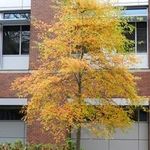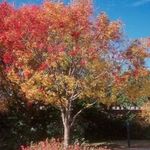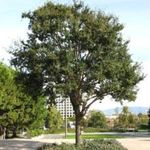Trees Suitable for Planting in Lawns in Contra Costa County
←
→
Page content transcription
If your browser does not render page correctly, please read the page content below
ccmg.ucanr.edu February 2020
Trees Suitable for Planting in Lawns in Contra Costa County
The UC Master Gardener Program in Contra Costa is frequently asked to provide suggestions for trees that are suitable
for planting in lawns in our area. Before selecting a tree, there are many things to be considered. The initial investment
may be small, but it can cost thousands of dollars to remove a tree and start over.
WHAT WILL BE THE PURPOSE OR GENERAL TREE PLACEMENT:
FUNCTION OF YOUR TREE ?
◗ Is it to be used as a landscape accent, West
providing blossoms or fall color?
◗ Is its purpose to provide shade for the H
NORT
home and garden? A deciduous tree
planted on either south or west sides can
lower utility costs and allow for solar
h
heating in winter months. Sout
◗ Is it to be used to frame views or screen
objectional elements?
MATURE SIZE AND SITE CONDITIONS: t
Eas
◗ Do not plant any tree that at maturity will
come within 10' of a power line.
◗ Avoid planting in close proximity to
underground utilities.
LAWN COMPATIBILITY:
◗ Plant 15' away from permanent structures.
◗ Select trees which can sustain the
◗ Select a tree which does not grow to block frequent watering that is necessary to
a view. maintain a lawn. Encourage deep, less
frequent watering around trees.
◗ Locate lawn sprinklers in a way that
the trunk will not be hit so that water
on the trunk will not promote crown
rot.
◗ Avoid trees with dense canopies. Most
lawn grasses require at least 4-5 hours
of full sun each day. Choose trees
which: provide filtered sunlight; can
be pruned selectively to allow sunlight
to penetrate; or can be limbed up to 8'
to allow direct sun on the lawn in the
early morning and late afternoon.
v-2020-02-28 1 of 7
The University of California prohibits discrimination or harassment of any person in any of its programs or activities. See the complete Nondiscrimination Statement at ucanr.edu.ccmg.ucanr.edu Trees Suitable for Planting in Lawns in Contra Costa County February 2020
CLIMATE AND SOIL:
◗ Select trees appropriate for your climate zone.
The New Sunset Western Garden Book has divided Contra Costa County into four zones: Zone
14 which includes much of central and east county; Zone 15 which includes El Sobrante,
Hercules, and parts of Orinda, Martinez, Walnut Creek and Concord; and Zones 16 and 17
which include the west county and areas with more moist air, summer fog, and coastal
thermal belts. For a detailed map see the New Sunset Western Garden Book or the following
website:
https://www.sunset.com/garden/climate-zones/sunset-climate-zone-bay-area
Though most of the trees listed are compatible in all zones in Contra Costa County, some cannot
take the heat of Zone 14 and others dislike the cool air and fog of Zones 16 and 17.
◗ Select trees compatible with your soil pH. Many trees do not perform well in alkaline soil.
◗ Select trees which tolerate the drainage characteristics of your soil. Many trees planted in lawns in
poorly drained soils are susceptible to root and crown rot.
PEST AND DISEASE RESISTANCE: ADDITIONAL REFERENCES:
◗ Trees vary in pest and disease resistance. The New Sunset Western Garden Book.
◗ Select trees that have known resistance to key Ninth Edition, 2012
local pests.
Plants and Landscapes for Summer-Dry
◗ Do not plant species highly susceptible to root Climates of the San Francisco Bay Region.
and crown diseases in poorly drained soil. East Bay Municipal Utility District, 2004
PERSONAL PREFERENCES AND AESTHETICS: Landscape Plants for California Gardens: An
◗ Consider tree characteristics such as shape, Illustrated Reference of Plants for California
bark pattern, leaves and flower and fruit color. Landscapes.
Bob Perry, 2010
◗ Consider possible leaf, flower and fruit litter.
◗ Select a tree that will fit your personal taste and SelecTree: A Tree Selection Guide.
landscape needs. https://selectree.calpoly.edu/
◗ Consider deciduous and evergreen Urban Forest Ecosystems Institute
characteristics. Deciduous trees drop their Cal Poly San Luis Obispo
leaves at the end of each growing season.
Evergreen trees retain leaves or needles longer
than one growing season so that some leaves
are present throughout the year.
v-2020-02-28 2 of 7ccmg.ucanr.edu Trees Suitable for Planting in Lawns in Contra Costa County February 2020
TREE TABLES
The following tables are a quick reference to a few of the more common trees
suitable for planting in lawns, divided into deciduous and evergreen trees
appropriate to various Contra Costa County climate zones. Trees listed here are
generally available at local nurseries, however there are a few trees that may be
more difficult to locate.
Size Zone
-------
Deciduous Trees ------- Exposure
-------
Comments
Growth Rate Water Needs
Leaves airy and delicate. Spring growth is red; summer,
Acer palmatum 20' H Z 14-17 green; fall, scarlet, orange or yellow. Many varieties
Japanese Maple 20' W available. Protect from hot sun and dry winds in inland
areas. Best in areas with summer fog.
Resistant to oak root fungus. Susceptible to verticillium
Deciduous slow wilt.
Acer rubrum 60' H Z 14-17 Leaves 2-4" long with 3-5 lobes, shiny green above, pale
Red Maple, Scarlet Maple 40' W beneath, turn brilliant scarlet in fall in frosty areas. Dull
red fruit. Tolerates most soils. Requires a constant
supply of water. Needs occasional deep watering to
Deciduous keep roots deep.
fast
Celtis australis 40-60' H Z 14-16 Tolerates most soils, takes sun, wind, and drought.
Roots not invasive. Branches upright, dark green leaves
European Hackberry 30-35' W 2-5 inches long. Shorter deciduous period than other
hackberries.
Deciduous moderate Resistant to oak root fungus.
Celtis sinensis 40' H Z 14-16
Chinese Hackberry 40' W Similar growth to European Hackberry, but smaller.
Leaves smoother and glossier than other hackberries.
Deciduous moderate
20' H Multi-stemmed shrub which can be trained as a small
Chionanthus retusus Z 14-17 tree. 2-4" leaves. Magnificent white blossoms late
Chinese Fringe Tree 20' W spring to summer. Handsome gray brown bark. Male
plants have larger flowers and no fruit.
Resists most pests and diseases. Can get fungal leaf
Deciduous slow spot and powdery mildew.
Ginkgo biloba 35-50' H Z 14-17 Light green fan shaped leaves spring and summer; gold
in fall. Plant only male trees as females produce smelly,
Maidenhair Tree 20-30' W messy fruit.
Resistant to oak root fungus. Susceptible to
Deciduous slow anthracnose.
v-2020-02-28 3 of 7ccmg.ucanr.edu Trees Suitable for Planting in Lawns in Contra Costa County February 2020
Size Zone
-------
Deciduous Trees ------- Exposure
-------
Comments
Growth Rate Water Needs
Koelreuteria bipinnata 20-40' H Z 14-17 1-2' long leaves divided into many oval leaflets, hold
onto tree until December. Yellow fall flowers turn into
Chinese Flame Tree 20-40' W 2" long salmon-red-orange seed capsules which
moderate- resemble little Japanese lanterns. Roots not invasive.
Deciduous fast Occasional beetle or scale problems.
Leaves to 15" with 7-15 lobed leaflets, 1-3" long. 8-14"
Koelreuteria paniculata 20-35' H Z 14-17 long showy yellow flowers in summer. Fruit capsules
Goldenrain Tree 25-40' W red when young, mature to buff-brown, last into fall.
Gawky when young, prune to shape. Tolerates cold
heat, drought, wind.
Deciduous moderate Susceptible to verticillium wilt. Pests are beetle, scale.
Lagerstroemia fauriei ⨉ To 25' H Z 14 Showy red, pink, lavender or white flowers in summer,
indica cultivars 15-25' W interesting bark, brilliant fall color. Can be purchased
Crape Myrtle as a multi-trunk tree or trained as a single trunk.
Hybrids between L. indica and L. fauriei have been
selected for hardiness & mildew resistance.
Deciduous moderate
Magnolia ⨉ soulangiana To 25' H Z 14-17
Blooms in late winter to early spring before leaves
Saucer Magnolia 25' W emerge. Striking flowers range from white to shades of
pink and purple. Blooms at 3-5 years old. Irregularly
branching tree with 5-7" long leaves.
Deciduous moderate
Magnificent flowering plants featuring blooms in white,
Magnolia spp. 12-35' H Z 14-17 pink, red, purple or yellow. Variety of leaf shapes and
Magnolia 10-25' W plant forms. See Sunset Garden Book for varieties; for
example M. acuminata, M. Kosar-De Vos hybrids, M. x
slow - loebneri, and M. stellata hybrids.
Deciduous moderate Some varieties subject to aphid, scale and spider mite.
Malus spp. 15-30' H Z 14-17 Brief, lavish, white pink or red flowers in spring
followed by showy red fruit.
Flowering Crabapple 10-20' W
Susceptible to rust, scab, powdery mildew and
slow - fireblight. Select newer more disease-resistant
Deciduous moderate varieties.
Nyssa sylvatica 30-50' H Z 14-17
Shape is pyramidal when young, irregular with age.
Sour Gum, Tupelo 15-25' W Leaves dark green, glossy 2-5" long, turning yellow and
orange then bright red in fall. Female trees set bluish
slow - black fruit if male tree is nearby which can be messy.
Deciduous moderate
Medium green divided leaves with 10-16 pairs of 2-4"
Pistacia chinensis 20-35'+ H Z 14-16 long leaflets. Small flowers; female trees have blue-
Chinese Pistache 20-35' W black berries. Leaves turn bright orange-red and yellow
in fall. Tolerates a wide range of soils and conditions.
slow -
Resistant to oak root fungus. Subject to verticillium wilt
Deciduous moderate with regular lawn watering in poorly drained soils.
v-2020-02-28 4 of 7ccmg.ucanr.edu Trees Suitable for Planting in Lawns in Contra Costa County February 2020
Size Zone
-------
Deciduous Trees ------- Exposure
-------
Comments
Growth Rate Water Needs
Native to eastern U.S. Leaves are 3-6" long with
Quercus coccinea 60-80' H Z 14-17 pointed, deeply cut lobes which turn scarlet where fall
Scarlet Oak 40-60' W nights are cold; best oak for fall color. Pyramidal when
young; round topped at maturity. Likes deep, rich soil;
deep rooted.
Deciduous fast Resistant to verticillium wilt. Fairly pest free.
Native to eastern U.S. 5-9" long by 4-6" wide lobed
Quercus rubra 60-75' H Z 14-17 leaves which turn red, orange, or brown in fall. Likes
Red Oak 50' W deep, rich soil; deep rooted. High branching habit.
Resistant to verticillium wilt. Host to fungus that causes
sudden oak death. Susceptible to anthracnose, root
Deciduous fast rot, aphids, caterpillars & gall.
6-10" leaves dark green leaves divided into 7-17
Sophora japonica 35-60' H Z 14-17 leaflets, 1-2" long. 12" long, open flower clusters of ½"
Japanese Pagoda Tree or 25-40' W yellowish white flowers throughout summer; 2.5-3"
Chinese Scholar Tree pods.
Susceptible to verticillium wilt and spider mites.
Deciduous moderate Resistant to oak root fungus.
Tilia cordata 35-50' H Z 14-17 Pyramidal form. Leaves 1.5-3" long and as wide. Small,
fragrant, yellowish white flowers in July which attract
Little Leaf Linden 15-30' W bees. Best in deep, rich soil. Good lawn tree. Select
varieties for size, form and blooming habit.
Deciduous moderate Susceptible to root rot, aphids & mildew.
Size Zone
-------
Evergreen Trees ------- Exposure
-------
Comments
Growth Rate Water Needs
Elaeocarpus decipiens 30-60' H Z 14-17 Blooms in summer, producing tiny, scented white
flowers in clusters; blue-black olive like fruit in winter.
Japanese Blueberry Tree 20-30' W
Glossy green foliage. Very ornamental effect from older
leaves, which turn bright red before dropping. Needs
Evergreen rich, well-drained soil. Requires little pruning.
Eriobotrya japonica 15-30' H Z 14-17 Leathery 6-12" long leaves, glossy green above, woolly
rust colored beneath. Dull white flowers in fall. Orange
Loquat 15-30' W to yellow fruit in winter to spring. If planted for fruit,
select a grafted variety. Plant in well drained soil.
Evergreen Subject to fire blight.
Magnolia doltsopa 20-40' H Z 14-17
Highly, pleasantly fragrant white flowers, 5-7" wide,
(Michelia doltsopa) 15-25' W cover the tree from late winter to early spring. Leaves
Sweet Michaelia are dark green above, pale beneath, 6-8" long, and
hang in pendulous manner.
Evergreen slow
v-2020-02-28 5 of 7ccmg.ucanr.edu Trees Suitable for Planting in Lawns in Contra Costa County February 2020
Size Zone
-------
Evergreen Trees ------- Exposure
-------
Comments
Growth Rate Water Needs
Metrosideros excelsa Big clusters of dark red flowers cover branch ends in
15-30' H Z 16,17 late spring and early summer. 'Aurea' has yellow
New Zealand Christmas 15-30' W flowers. Large leathery leaves, dark green above, white
Tree woolly beneath. Best suited to areas where there is fog
and cool summer temperatures.
Evergreen moderate Susceptible to root rot.
Moderately fast growth to 15', slow to 30-40'. Single or
Pittosporum undulatum 25-40' H Z 16,17 multi-trunked dome shaped tree. Glossy green, wavy-
Victorian Box 25-30 W edged, 6" long leaves. Creamy white flowers in early
spring; orange-yellow fruit in late spring can be a litter
problem. Strong roots become invasive with age.
Evergreen moderate Pests are aphids and scale.
Best in deep, rich, moist soil. Grows well as a lawn tree
Quercus virginiana 40-70' H Z 14-17 with regular moisture; tolerates heat, aridity and
Southern Live Oak to 90'W winds. Iconic tree of southeastern U.S. Partly
deciduous in cold winter regions.
moderate
Resistant to verticillium wilt. Susceptible to oak root
Evergreen to fast fungus and root rots.
Rhus lancea 20-30' H Z 14-17 Graceful weeping outer branchlets. Dark green willow-
like 4-5" long leaves. Inconspicuous spring flowers
African Sumac 20-35' W followed by clusters of yellow or red fruit that can be
messy. Single or multi-trunk.
Evergreen slow Susceptible to Texas root rot.
Low Water Full Sun
Moderate Water Part Shade
Regular Water Full Shade
High Water Z New Sunset Western Garden Book, 2012 ed.—Climate Zones
Photography & Illustration Credits
Cal Poly San Luis Obispo Urban Forest Ecosystems Institute, https://ufei.calpoly.edu/: Celtis australis, Celtis sinensis, Chionanthus
retusus, Koelreuteria bipinnata, Magnolia doltsopa, Metrosideros excelsa, Pittosporum undulatum, Quercus rubra, Quercus virginiana, Rhus
lancea, and Sophora japonica with permission.
Oregon State University Department of Horticulture, Pat Breen, "Landscape Plants, Images and Identification", 1999-2013,
https://landscapeplants.oregonstate.edu/ : Acer rubrum, Eriobotrya japonica, Koelreuteria paniculata, Lagerstroemia cv., Magnolia ⨉
soulangiana, Magnolia sp., Nyssa sylvatica, Pistacia chinensis, Quercus coccinea, and Tilia cordata with permission.
UC Master Gardener Program of Contra Costa County, Martha Lee: Acer palmatum, Ginkgo biloba.
Photobucket.com, https://s212.photobucket.com/user/wdwplants/media/Magic%20Kingdom%20trees/99b0.jpg.html: Elaeocarpus decipiens.
University of California, Agriculture & Natural Resources, Will Suckow: Tree Placement Illustrations.
v-2020-02-28 6 of 7ccmg.ucanr.edu Trees Suitable for Planting in Lawns in Contra Costa County February 2020
Trees Not Recommended for Planting in Lawns
Many trees which grow in Contra Costa County have not been included on the list of trees
suitable for planting in lawns. They may be intolerant of wet soils, have highly competitive roots,
grow to a size which quickly overpowers the average size lawn, or be highly susceptible to pests
and diseases. A few examples of common trees not recommended for planting in lawns are:
Albizia julibrissin (Silk Tree, Mimosa) Invasive. Messy leaves, flowers, and pods.
Betula spp. (Birch) Requires ample water at all times and a regular feeding program.
Intolerant of drought. Susceptible to aphids and bronze birch
borers. Very sensitive to lawn pre-emergent herbicides.
Cedrus deodara (Deodar Cedar) Produces prodigious amounts of pollen, catkins and cone scales.
Fast growing and quickly overpowers the average lawn.
Cinnamon camphora (Camphor Tree) Roots are very competitive. Subject to root rot and verticillium
wilt.
Fraxinus modesto (Modesto Ash) Susceptible to anthracnose, aphids, bugs, mistletoe. Branches
split to due narrow crotch. Lawns do poorly underneath.
Liquidambar styraciflua (Sweet Gum) Heavy surface roots. Seeds pods interfere with mowing.
Morus alba (Fruitless Mulberry) Heavy surface roots. Produces prodigious amounts of pollen.
Subject to sooty canker disease, chlorosis, and bacterial blight.
Platanus acerifolia (London Plane Tree) Invasive roots. Susceptible to spider mite, powdery mildew and
anthracnose. If used, select for disease resistance: 'Bloodgood' is
resistant to anthracnose; 'Yarwood' is mildew resistant; and
'Columbia' is resistant to both.
Prunus spp. (Flowering Cherry) Requires fast draining and well aerated soil. Subject to crown rot.
Quercus agrifolia (Coast Live Oak) and California native oaks succumb to fungal root diseases if given
Quercus lobata (Valley Oak) regular summer watering. However, there are oaks listed which
are native to the southern and eastern parts of the U.S. which do
well in lawns.
Sequoia sempervirens (Coast Redwood) Loves being in or near a lawn for the water, but overpowers the
lawn in 10-20 years.
Ulmus parvifolia (Chinese Elm) Aggressive roots. Branch crotches are narrow and easily split.
Subject to bark beetles, leafhopper, aphids and scale. Dutch Elm
disease has historically been a problem in California.
March 2003, UC Master Gardener Program of Contra Costa County
Last revised November 2013 by UC Master Gardeners Martha Lee,
Steve Morse, Shawna Anderson & Sharon Gibson
v-2020-02-28 7 of 7You can also read



























































